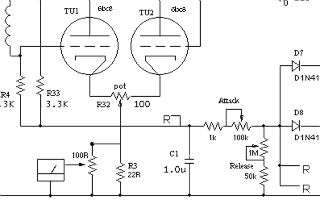dukasound
Well-known member
Also, can I use 51K instead 50K in series with release pot.
Thanks
Duka
Thanks
Duka
Next came an amp (which I bought for 1 pound) with a 12" speaker and a pair of KT33C's as the output valves producing the best 10 watts anyone heard (great for the early Rolling Stones numbers). However, unknown to me at the time, this was a lethal device (AC/DC operation, with no mains transformer to provide a degree of safety). Yes, you guessed it -- at one gig, early on, I caught the full whack of 235 volts mains across my hands and chest! I soon learned to insert the mains plug for correct polarization (where there were still 2-pole operation circuits here). This happened in 1964 and I'm still here today with no ill effects (I think!).
Can I just change R3 and R4 (the 220ohm resistors in the power supply)
to get enough juice for the v-regs? up or down.
I think I need to do something like this, but I'm not sure where to get small "negative bias"Larrchild said:I've had good luck with a vu meter(non buffered), internal rectifiers included.. I use a cal pot and also some small negative bias off another pot on the ground side to calibrate it in db's of gr.
